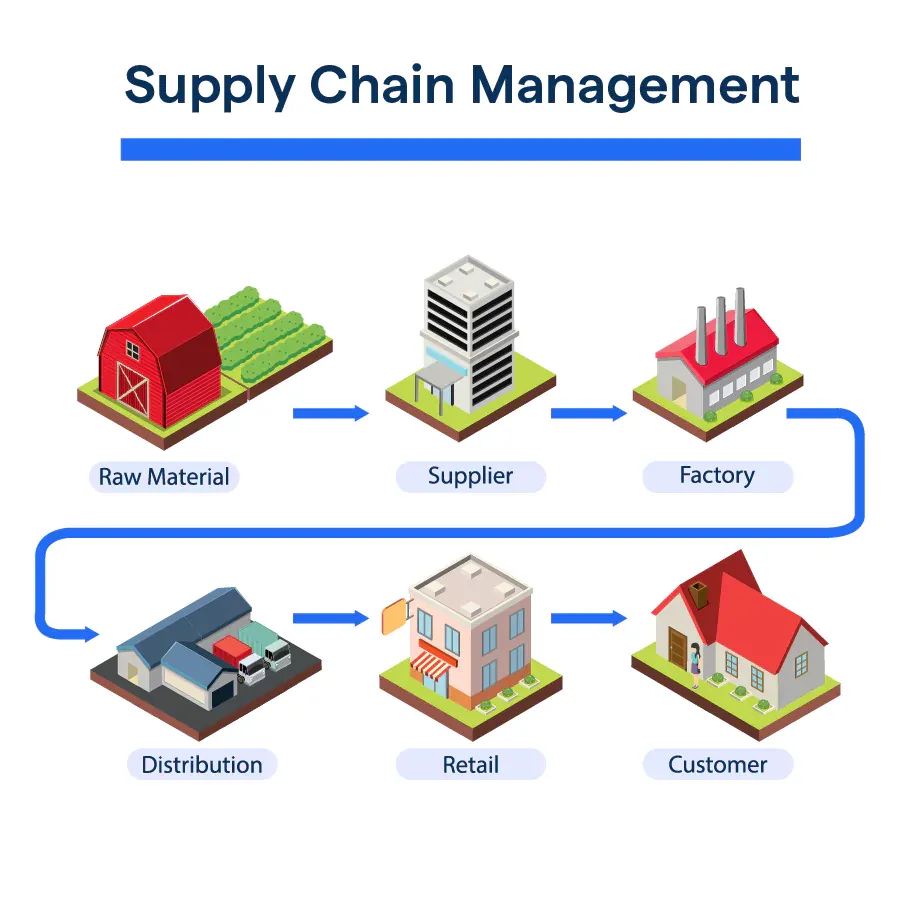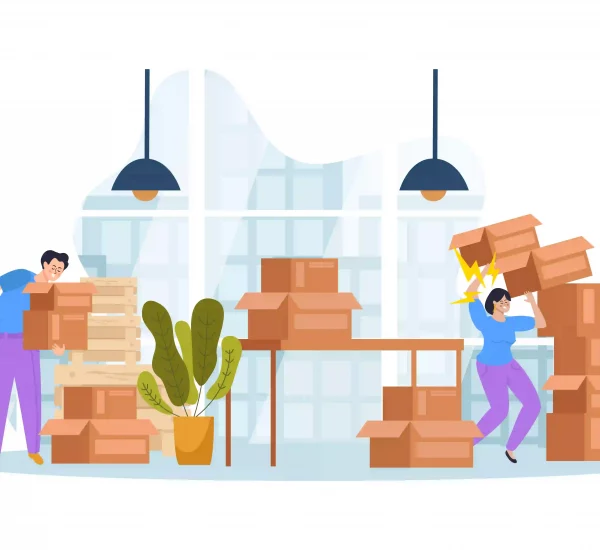“We need a frictionless supply chain.”
“We have to optimize our supply chain management.”
“We have to procure these supplies.”
If you have a business, you might be very much aware of these rants.
In reality, these are not just rants but some of the most important parts of running a business. But some might think that procurement and supply chain management are either the same or very different.
They are neither the same nor very different. Still, they are related to each other in such a way that the entire input (identifying and supplying products) and output (manufacturing, logistics, end product) of any business depend on both.
Let’s find out the major procurement and supply chain management roles for a business.
Where do they overlap to make business decisions and operations smoother and finer?
And how businesses can see up to a 20% reduction in operational costs by simply integrating both.
What is a Supply chain?
A supply chain is a complete cycle and an interconnected network of people, organizations, resources, and activities (Logistics) responsible for the complete product life cycle, from acquiring raw material to delivering the final product to the end consumer.
What is Supply chain management?
Supply chain management is a complete process of managing the supply chain from sourcing to manufacturing, storage, transportation and distribution. In short, from the point of origin of the products to the point of consumption, supply chain management handles all.
These are the components that make a complete SCM process.
Planning: Forecasting demand and aligning resources accordingly.
Sourcing: Procuring raw materials and components.
Manufacturing: Transforming raw materials into finished products.
Logistics: Managing transportation and warehousing.
Returns Management: Handling product returns and recycling.
What is procurement?
Procurement is the process of acquiring goods and services from suppliers. It starts when a person or a department identifies the need for a product or service and ends with acquiring that product or service.
The procurement process moves like this;
Identifying needs → Selecting suppliers → Negotiating contracts → Managing purchase orders.
To study the procurement or procure-to-pay process in detail, read this.
The procurement process fulfils any business’s product need, making it a subset and a part of the supply chain. Supply chain management is much broader. It basically starts from acquiring goods and then moves further into product manufacturing, distribution, and so on. The interesting part is that businesses that integrate both and make informed decisions can see a 15% improvement in supplier performance.
What are the major differentiators between procurement and supply chain management?
While dividing tasks between departments, have you ever considered which team should manage inventory? A supply chain department or procurement department? If you still do not get the answer, let me explain further.
Let’s suppose you own an automobile business. You find a wholesale supplier in China that deals in automobile parts. Procurement involves identifying needs (that you need automobile parts) and placing an order. After that, the work shifts to the SCM department, which will make sure the product arrives on time (manage logistics), is stored properly, reaches manufacturers, and then delivers the end product to the customer in time.
Now are we clear?
To answer the above question: Procurement might plan the inventory, but SCM will manage it.
Difference between the main goals of procurement and SCM
Procurement focuses on:
- Getting the best value for money.
- Finding reliable suppliers.
- Reducing purchase costs without compromising quality.
- Making sure the business has what it needs, when it needs it.
SCM focuses on:
- Keeping the product flow moving smoothly from start to finish.
- Managing supply risks (e.g., delays, shortages).
- Balancing supply and demand.
- Making sure products are available, affordable, and delivered on time.
Difference between the key activities involved in procurement and SCM
- Where Procurement identifies the internal needs of a business (Inputs), the SCM forecasts customer demand (outputs).
- Procurement manages where to source based on supplier qualification. SCM manages those raw materials and ensures smooth and timely logistics to prevent delays and make sure the finished product reaches the customer on time.
- Procurement mostly deals with the supplier part, like requesting quotes and comparing supplier processes, to get the most out of it, while SCM plans and manages production and logistics schedules.
- Procurement negotiates supplier contracts while SCM oversees warehousing and inventory.
- Where procurement manages purchase orders, SCM helps coordinate logistics and transportation.
- Where procurement manages supplier relationships, SCM builds customer relationships by handling customer service, such as quick deliveries and product returns.
The difference between the impact of procurement and SCM on business
Procurement impacts:
- Costs (buying at the right price)
- Product quality (choosing reliable suppliers)
- Supplier relationships
SCM majorly impacts:
- Delivery speed
- Inventory turnover
- Customer satisfaction
- And overall business efficiency
| Procurement | Supply Chain Management | |
| Purpose | Buying goods/services | Managing product flow end-to-end |
| Focus | Cost, quality, and supplier terms | Efficiency, delivery, risk reduction |
| Scope | One function in the supply chain | Covers all stages from sourcing to delivery |
| Timeframe | Short-term (immediate needs) | Short- and long-term planning |
| Teams involved | Purchasing, finance | Logistics, operations, and inventory |
| Key tools | Vendor portals, POs, contract tools | ERP, inventory systems, shipping tools |
| Business impact | Saves money and secures good suppliers | Improves service, reduces delays, and waste |
Where Procurement and Supply Chain Management Overlap
Now that we know the possible differences between both processes, we can identify where they overlap, which can help optimize overall business operations.
Isn’t this fun?
You can save millions of dollars just by determining which part of the process needs to be optimized more and vice versa.
Cost reduction:
With the proper integration of procurement and SCM, you can reduce costs. But where and how?
After you identify the product’s need, you qualify a supplier. If you develop a long relationship with some of your regular suppliers (like procurement should), you can negotiate lower material and logistics costs. That can equally benefit the supplier, logistics, and the business itself. According to Supply Chain Brain, if a business plans its inventory collectively, it can save 10-15% in inventory costs and increase its inventory turns by 5-10%.
Risk mitigation:
Suppose you are in the middle of a geopolitical crisis, and you remember how you are going to get supplies from your supplier (from a different country). This will delay the whole cycle. What am I going to do now?
To prevent this situation, you must have shared data on procurement and the supply chain at hand. When the SCM department can access data from another department, it can identify where to find some local raw product suppliers quickly and easily, and it can optimize its overall supply chain by informing logistics in time, storing, distributing, etc.
For example, during the 2023 chip shortage, companies with integrated teams diversified suppliers faster.
Quality assurance:
The procurement department audits vendors to identify and verify their quality and ensure that they meet the organization’s standards. This process complements supply chain production checks.
How?
Because the vendors are qualified, the SCM departments don’t need to undergo this step again. They can jump straight into manufacturing after the procurement team acquires the products. Thus, the SCM department can manage logistics, warehousing, and engineering, which strengthens the quality control in the supply chain and saves a lot of time for separate quality assurance.
How does this overlap bring business success?
1- Faster time-to-market:
When less time is consumed performing the same procurement process twice, businesses can actively speed up their time-to-market ratio. When procurement and supply chain management collaborate, businesses can see 30-50% shorter product development cycles that increase overall product quality by 20-30%.
2- Increased Visibility:
The second major benefit of this collaboration is increased visibility. When the data from both departments is available on a single platform, it’s easier to improve demand forecasting. This means they can forward orders ahead of time, check which stage the product is in the product lifecycle, and see how logistics is contributing to quick transportation.
However, Metrobi reports that only 6% of businesses achieve full supply chain visibility. Because most businesses are still working with older models, where they either don’t have separate departments or operate different teams with little or no collaboration, which increases lead times.
3- Sustainability:
Metrobi reported that the carbon emissions produced within the supply chain are 5 -10 times greater than those from direct manufacturing (which is only 5%). Joint initiatives can reduce these carbon footprints.
With accurate demand forecasting, businesses can decide how much manufacturing they need for a specific period and how long it takes for logistics to deliver that to the destination. With data in hand, businesses can make informed decisions about manufacturing (preventing extra or unannounced production) and optimizing shipping routes that minimize emissions. This can also shorten the product development and distribution cycles. That’s how collaboration between two can bring sustainability to the whole supply chain process.
How do you integrate your procurement and supply chain management?
The easiest way to streamline both is to use software that manages procurement and supply chain under one platform and gives you real-time data for better demand forecasting.
Accurate demand forecasting means quicker decisions, which ultimately reduce delays like production delay, transportation delay, and distribution delay.
Conclusion
It takes a lot of effort and the right decisions to make a business successful. Even a single delay in the supply chain can impact overall business operations. Businesses also need to optimize their supply chains to save money that could be used elsewhere. One way to do this is to bring procurement and supply chain management departments together, shortening product development and distribution cycles.
Start integrating your procurement and supply chain management today using tools and software – Work smarter, not harder.
FAQs
What is procurement?
Procurement is the process of acquiring goods and services from suppliers. It starts when a person or a department identifies the need for a product or service and ends with acquiring that product or service.
The procurement process moves like this;
Identifying needs → Selecting suppliers → Negotiating contracts → Managing purchase orders.
What is supply chain management?
Supply chain management is a complete process of managing the supply chain from acquiring raw materials to manufacturing, storage, transportation, and distribution. In short, from the point of origin of the products to the point of consumption, supply chain management handles all.
What is a supply chain?
A supply chain is a complete cycle and an interconnected network of people, organizations, resources, and activities (Logistics) responsible for the complete product life cycle, from acquiring raw material to delivering the final product to the end consumer.
What is procurement and supply chain management all about?
Procurement is about identifying and acquiring goods that a business needs, while supply chain management is a process of sourcing, manufacturing, storing, transporting, and distributing the finished products to the end consumer. By integrating both, businesses can optimize their overall product development and distribution cycles by reducing inventory costs and increasing visibility.






